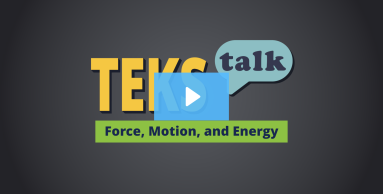- Science
- Grade 3
- Force, motion, and energy
Science.3.8.A
identify everyday examples of energy, including light, sound, thermal, and mechanical; and

Knowledge and Skills Statement
The further explanation is designed to be a resource for educators that helps them better understand the topic their students are learning. Further explanations may be written at a more complex level than would be expected for students at the grade level.
Heat and thermal energy are related but are not the same. When the particles of a substance move, they have thermal energy. An increase in thermal energy will make particles move faster, causing an increase in temperature. A decrease in thermal energy will make particles slow down, causing a decrease in temperature. Heat is the transfer of thermal energy from one object to another. Energy will always move from the object with more thermal energy into the object with less thermal energy. When an object feels warm, thermal energy is moving from the object into your skin. When an object feels cool, thermal energy is moving out of your hand into the object.
Objects have mechanical energy not only if they are moving but also if they are in a position to move, such as a ball in your hand before you drop it or a compressed spring before you let go. Mechanical energy exists, whether it is stored as gravitational or elastic potential energy or active as kinetic energy.
Research
Kolb, Jennifer. 2009. “Hunting for Energy.” Science and Children 47, no. 4 (December 2009): 42–44. https://www.proquest.com/docview/236912040?pq-.origsite=gscholar&fromopenview=true&sourcetype=Scholarly%20Journals.
Summary: Students in this article identify different types of energy and how energy can be transferred. Teachers should start by identifying what students already know about energy and what misconceptions they already have. Students should understand that energy is all around us and can be easily observed. The teacher in this article had students walk the school looking for different energy forms. Students could easily identify items like televisions and lights as having energy but struggled to identify heat and light energy forms. Students also assumed that any object that moved must have energy. As a class, students then classified types of energy. Students then worked in pairs to identify and classify energy by type. After students easily identified different forms of energy, they discussed how energy is transferred. When this happens, the energy is only changed but not lost. The teacher used a lamp as an example where the energy changes from electrical to heat and light.
